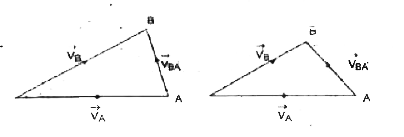A siren placed at a railway platfrom is emitted sound of frequency 5kHZ, A passenger sitting in retun journey in a different train B he records a frequency of 6.0kHZ while approaching the same siren. The ratio of the velocity of train B to that of train A is
242/252
2
4
6
The correct Answer is:B
VA+VV=5.55,VB+VV=65
Solve to get VBVA=2
Topper's Solved these Questions
- BOOK - VMC MODULES ENGLISHCHAPTER - WAVE MOTIONEXERCISE - JEE ADVANCED ARCHIVE LEVEL 2 (MUTIPLE CORRECT TYPE)20videos
WAVE MOTION
- BOOK - VMC MODULES ENGLISHCHAPTER - WAVE MOTIONEXERCISE - JEE ADVANCED ARCHIVE LEVEL 2 (PARAGRAPH TYPE)6videos
WAVE MOTION
- BOOK - VMC MODULES ENGLISHCHAPTER - WAVE MOTIONEXERCISE - JEE MAIN ARCHIVE LEVEL 156videos
WAVE MOTION
- BOOK - VMC MODULES ENGLISHCHAPTER - UNITS, MEASUREMENTS & ERRORSEXERCISE - IN - CHAPTER EXERCISE - B10videos
UNITS, MEASUREMENTS & ERRORS
- BOOK - VMC MODULES ENGLISHCHAPTER - WORK ENERGY AND POWER EXERCISE - IMPECCABLE54videos
WORK ENERGY AND POWER
Similar Questions
A siren placed at a railway platform is emitting sound of frequency 5kHz. A passenger sitting in a moving train A records a frequency of 5.5kHz while the train approaches the siren. During his return journey in a different train B he records a frequency of 6.0kHz while approaching the same siren. the ratio the velocity of train B to that of train A is
View SolutionAn observer standing on a railway crossing receives frequencies 2.2 kHz and 1.8 kHz when the tran approaches and recedes from the observer. Find the velocity of the train (speed of sound in air is 300 m/s).
View Solution
Knowledge Check
- Question 1 - Select One
A train approaching a railway platform with a speed of 20 m s−1 starts blowing the whistle. Speed of sound in air is 340 ms−1. If the frequency of the emitted sound from the whistle is 640 Hz, the frequency of sound as heard by person standing on the platform
A600 HzB640 HzC680 HzD720 Hz
A siren emitting a sound of frequency 1000HZ moves away from you towards a cliff at a speed of 10m/s .
(a) What is the frequency of the sound you hear coming directly from the sirven ?
(b) What is the frequency of sounds you hear reflected off the cliffb ?
(c) What beat frequency would you hear ? Take the speed of sound in air as 330m/s .View SolutionA train, standing at the outer signal of a railway station blows a whistle of frequency 400Hz in still air. (i) What is the frequency of the whistle for a platform observer when the train (a) approaches the platform with a speed of 10ms−1 , (b) receeds from the platform with a speed of 10ms−1? (ii) What is the speed of sound in each case ? The speed of sound in still air can be taken as 340ms−1
View SolutionA train standing at the outer signal of a railway station, blows a whistle of frequency 400 Hz in stil air. (i) What is the frequency of the whistle for a platform observer when the train (a) approaches the platform with a speed of 10ms−1. (b) recedes from the platform with a speed of 10 ms ? What is the speed of sound in each case? (V=340ms−1).
View SolutionThe vector difference between the absolute velocities of two bodies is called their relative velocity. The concept of relative velocity enables us to treat one body as being at rest while the other is in motion with the relative velocity. This jormalism greatly simplifies many problems. If →vAis the absolute velocity of a body A and →–––(B)that of another body B then the relative velocity of A in relation to B is →–––(AD)=→VA−→vB and →vBA=→vB-→vA.
The principle follows here is that the relative velocity of two bodies remains unchaged if the same additional velocity is imparted to both the bodies. A simple way of carrying out this operation is to be represent the velocities in magnitude and direction from a common point. Then the line joining the tips of the vectors represents the relative velocity
Q A train A moves to the east with velocity of 40 km/hr and a train B moves due north with velocity of 30 km/hr. The relative velocity of A w.rt. B is View Solution
View SolutionStatement I: A person is standing near a railway trach. A train is moving on the track. As the train is approaching the person, apparent freqeuncy keeps on increasing and when the train has passed the person, then apparent freqeuncy keeps on decreasing.
Statement II: When train is approaching the person then,
f=f0[cc−u]
and when train is moving away from person
f=f0[cc+u]
Here, c is velocity of sound u is velocity of train and f0 is original frequency of whistle.View SolutionA railroad train is travelling at 30.0m/s in still air. The frequency of the note emitted by the train whistle is 262HZ . What frequency is heard by a passenger on a train moving in the opposite direction to the first at 18.0m/s and (a) approaching the first? (b) receding from the first? Speed of sound in air = 340m/s .
View SolutionTwo trains are moving towards each other at speeds of 72kmh−1 and 54kmh−1 relative to the ground. The first train sounds a whistle of frequency 600 Hz. Find the frequency of the whistle as heard by a passenger in the second train a. before the trains meet and b. after the trains have crossed each other. The speed of sound in air is 340ms−1
View Solution

